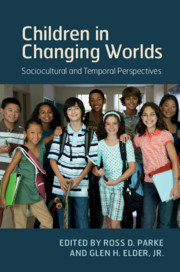Book contents
- Children in Changing Worlds
- Children in Changing Worlds
- Copyright page
- Contents
- List of Figures
- Contributor Biographies
- Preface
- Part I Theoretical and Methodological Approaches: A Cross-Disciplinary Challenge
- Part II Historical and Life Course Transitions: Economic and Demographic Change
- Part III Social, Legal, and Technological Change: Impact on Children
- Part IV Views of the Interdisciplinary Dialogue: From Developmental Science and Sociology
- Author Index
- Subject Index
- References
Part III - Social, Legal, and Technological Change: Impact on Children
Published online by Cambridge University Press: 18 July 2019
- Children in Changing Worlds
- Children in Changing Worlds
- Copyright page
- Contents
- List of Figures
- Contributor Biographies
- Preface
- Part I Theoretical and Methodological Approaches: A Cross-Disciplinary Challenge
- Part II Historical and Life Course Transitions: Economic and Demographic Change
- Part III Social, Legal, and Technological Change: Impact on Children
- Part IV Views of the Interdisciplinary Dialogue: From Developmental Science and Sociology
- Author Index
- Subject Index
- References
Summary
The goal of this chapter is to address how urban dynamics at the neighborhood level are linked to children’s development. We first review trends in the spatial concentration of poverty and inequality in the United States in recent decades. Then, we turn to theoretical models describing how local communities, with a focus on urban settings, influence children’s development. We then cover methodological issues and focus on one critical issue, selection bias, and then briefly review study designs as related to this challenge. Finally, we provide an overview of empirical studies linking neighborhood, socioeconomic conditions, and children’s development, notably their educational, behavioral, and socioemotional outcomes.
Keywords
- Type
- Chapter
- Information
- Children in Changing WorldsSociocultural and Temporal Perspectives, pp. 163 - 274Publisher: Cambridge University PressPrint publication year: 2019



